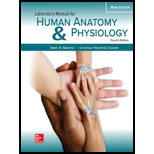
Laboratory Manual for Human Anatomy & Physiology Main Version
4th Edition
ISBN: 9781260159110
Author: Terry Martin
Publisher: Mcgraw-hill Higher Education (us)
expand_more
expand_more
format_list_bulleted
Textbook Question
Chapter 11, Problem 6PL
Frequent cell division occurs in the ______________ of the epidermis.
- stratum corneum
- stratum spinosum
- stratum granulosum
- stratum basale
Expert Solution & Answer
Want to see the full answer?
Check out a sample textbook solution
Students have asked these similar questions
18. Watch this short youtube video about SARS CoV-2 replication. SARS-CoV-2 Life Cycle (Summer 2020) - YouTube.19. What is the name of the receptor that SARS CoV-2 uses to enter cells? Which human cells express this receptor? 20. Name a few of the proteins that the SARS CoV-2 mRNA codes for. 21. What is the role of the golgi apparatus related to SARS CoV-2
State the five functions of Globular Proteins, and give an example of a protein for each function.
Diagram of check cell under low power and high power
Chapter 11 Solutions
Laboratory Manual for Human Anatomy & Physiology Main Version
Ch. 11 - Which of the following is not a function of the...Ch. 11 - The two distinct skin layers are the epidermis and...Ch. 11 - Apocrine sweat glands are located in __________...Ch. 11 - The hypodermis is composed of __________ tissues....Ch. 11 - The _________ of the epidermis is only present in...Ch. 11 - Frequent cell division occurs in the...Ch. 11 - Prob. 7PLCh. 11 - Thick skin of the palms and soles contains five...Ch. 11 - Figure 11.6 Label the features of the skin.Ch. 11 - Match the structures in column A with the...
Ch. 11 - How does the skin of your palm differ from that on...Ch. 11 - Describe the differences you observed in the type...Ch. 11 - Explain how a hair is formed.Ch. 11 - What portion of the nail plate is not visible on...Ch. 11 - Complete the following chart, and then circle the...Ch. 11 - How do the cells of stratum corneum and stratum...Ch. 11 - State the specific location of melanin observed in...Ch. 11 - Which is darker, the anterior forearm or the...Ch. 11 - What special qualities, due to the presence of...Ch. 11 - How is the structure of the thick skin of the...Ch. 11 - What part of the hair extends from the hair...Ch. 11 - In which layer of skin are sebaceous glands found?Ch. 11 - How are sebaceous glands associated with hair...Ch. 11 - Prob. 4.4ACh. 11 - Which type of sweat gland is most important in...Ch. 11 - Sketch a vertical section of human skin, using the...
Knowledge Booster
Learn more about
Need a deep-dive on the concept behind this application? Look no further. Learn more about this topic, biology and related others by exploring similar questions and additional content below.Similar questions
- a couple in which the father has the a blood type and the mother has the o blood type produce an offspring with the o blood type, how does this happen? how could two functionally O parents produce an offspring that has the a blood type?arrow_forwardWhat is the opening indicated by the pointer? (leaf x.s.) stomate guard cell lenticel intercellular space none of thesearrow_forwardIdentify the indicated tissue? (stem x.s.) parenchyma collenchyma sclerenchyma ○ xylem ○ phloem none of thesearrow_forward
- Where did this structure originate from? (Salix branch root) epidermis cortex endodermis pericycle vascular cylinderarrow_forwardIdentify the indicated tissue. (Tilia stem x.s.) parenchyma collenchyma sclerenchyma xylem phloem none of thesearrow_forwardIdentify the indicated structure. (Cucurbita stem l.s.) pit lenticel stomate tendril none of thesearrow_forward
- Identify the specific cell? (Zebrina leaf peel) vessel element sieve element companion cell tracheid guard cell subsidiary cell none of thesearrow_forwardWhat type of cells flank the opening on either side? (leaf x.s.) vessel elements sieve elements companion cells tracheids guard cells none of thesearrow_forwardWhat specific cell is indicated. (Cucurbita stem I.s.) vessel element sieve element O companion cell tracheid guard cell none of thesearrow_forward
arrow_back_ios
SEE MORE QUESTIONS
arrow_forward_ios
Recommended textbooks for you
 Anatomy & PhysiologyBiologyISBN:9781938168130Author:Kelly A. Young, James A. Wise, Peter DeSaix, Dean H. Kruse, Brandon Poe, Eddie Johnson, Jody E. Johnson, Oksana Korol, J. Gordon Betts, Mark WomblePublisher:OpenStax College
Anatomy & PhysiologyBiologyISBN:9781938168130Author:Kelly A. Young, James A. Wise, Peter DeSaix, Dean H. Kruse, Brandon Poe, Eddie Johnson, Jody E. Johnson, Oksana Korol, J. Gordon Betts, Mark WomblePublisher:OpenStax College Human Physiology: From Cells to Systems (MindTap ...BiologyISBN:9781285866932Author:Lauralee SherwoodPublisher:Cengage Learning
Human Physiology: From Cells to Systems (MindTap ...BiologyISBN:9781285866932Author:Lauralee SherwoodPublisher:Cengage Learning- Understanding Health Insurance: A Guide to Billin...Health & NutritionISBN:9781337679480Author:GREENPublisher:Cengage

Anatomy & Physiology
Biology
ISBN:9781938168130
Author:Kelly A. Young, James A. Wise, Peter DeSaix, Dean H. Kruse, Brandon Poe, Eddie Johnson, Jody E. Johnson, Oksana Korol, J. Gordon Betts, Mark Womble
Publisher:OpenStax College


Human Physiology: From Cells to Systems (MindTap ...
Biology
ISBN:9781285866932
Author:Lauralee Sherwood
Publisher:Cengage Learning

Understanding Health Insurance: A Guide to Billin...
Health & Nutrition
ISBN:9781337679480
Author:GREEN
Publisher:Cengage


The Integumentary System, Part 1 - Skin Deep: Crash Course Anatomy & Physiology #6; Author: CrashCourse;https://www.youtube.com/watch?v=Orumw-PyNjw;License: Standard youtube license